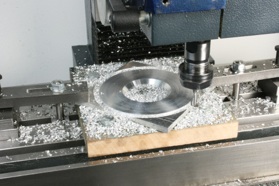CNC in the (Model Engineers’) Workshop

Part 4

The fourth instalment of CNC In The (Model Engineers’) Workshop was published in the September 2013 issue (no. 206) of Model Engineers’ Workshop, arriving at UK subscribers on 1st August 2013.
This finished the discussion of backlash measurement and compensation, dealt with cutting speeds and feed rates, then began the construction of a vice plate.
MEW Issue 206 : September 2013

Cutting Speeds and Feed Rates
Go to that section by clicking here.
Free Cutting Speed and Feed Rate calculator
Click here.
Please note that this calculator will only be available until 31st August 2013 (i.e. during the currency of MEW 206).
Vice Plate
Whether on a manual or a CNC mill, setting up work can take a surprising amount of time, so any aids which can maintain accuracy yet reduce setup time are welcome.
The vice plate is one of those items.
I originally thought I would add a tongue to the base of the vice, but worried that the fit in the T slots just wouldn’t be sufficiently tight or consistent. The T slots on my table are pretty consistent, but I reckoned any minor variation on fit would cause a degree of misalignment. Yes; I could have coped by remembering to always press the vice against the front (or rear) of the slot when I bolted it down, but that seemed a little less satisfactory than I wanted. I also felt quite strongly that there would be many occasions when I would want to mount the vice along the table, in which case the tongue would have been an obstruction.
There’s another factor too. As you will read in a future instalment, there are good reasons for arguing that the vice should always be set along the X axis, with its fixed jaw on the left, parallel to the Y axis. Most of the time, my vice sits fore-and-aft, with the fixed jaw to the rear, parallel to the X axis, but that’s no reason to suppose it is theoretically the best position.
Anyway; the vice is off and on the table as often as I am served hot dinners, so any speedy method of mounting it accurately helps. I chose the vice plate, so that the vice could be mounted in either position with great speed.
Making a vice plate allows us an excuse to practice using G0 and G1 commands, It’s hardly a high repetition job, and doesn’t play strongly to the strengths of a CNC mill, but that’s no reason not to use it as a project.
It will be developed further in issue 207.
With the articles, we are in the foothills of using instructions and creating Teach sequences and programmes. I believe a logical progression of knowledge and skills is the best course of action, at the moment. The pace will accelerate as we develop, so we will become more capable with increasing speed. The more you know, the faster you can learn and the more you can understand; I think.
If you want to learn at a much quicker pace, the forthcoming book may be of interest, because its like a collection of instalments you can cover at your own pace. The book and the magazine articles are different, though, and the approach will increasingly be different as the articles progress.
We follow the vice plate with a repetition stop.
Then I have a project in mind.

Download the article here